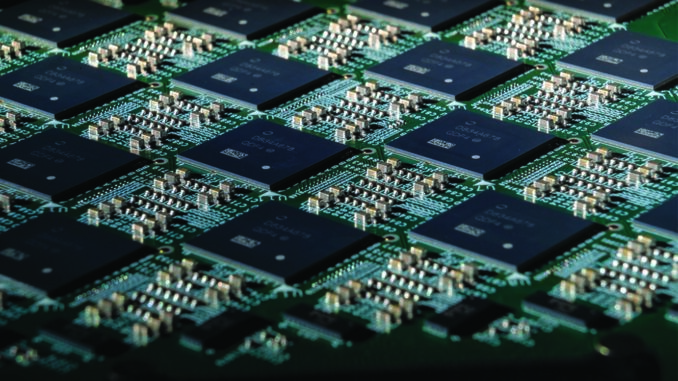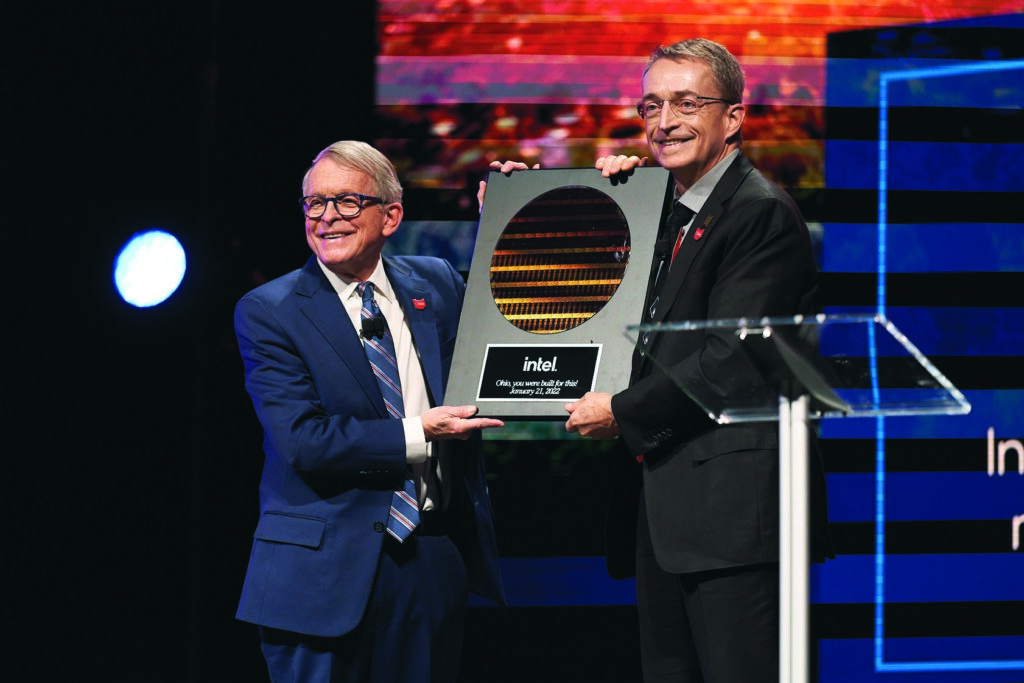
Are there winners and losers of its recent Ohio announcement?
By Terry Troy
Whenever there is a business deal of this magnitude, there are winners and losers, the haves and have-nots. Fortunately, with this deal, there are very few losers.
The numbers, of course, are staggering.
Intel announced last month that it would initially invest $20 billion in facilities in Central Ohio—the largest business investment in our state. Now, with the house passage of its portion for funding of the CHIPS Act, that investment could grow as high as $100 billion.
The initial investment is going toward the construction of two state-of-the-art facilities in New Albany near Columbus. With it, Intel will create more than 10,000 jobs, return our nation to its status as a world force in microchip production and forever transform our state’s economy.
Once considered among the top potato chip producing states in the nation, Ohio will soon become the leading state in terms of microchip production.
“Today’s announcement is monumental news for the state of Ohio,” Ohio Gov. Mike DeWine said in making the announcement last month. “Intel’s new facilities will be transformative for our state, creating thousands of good-paying jobs in Ohio manufacturing strategically vital semiconductors, often called ‘chips.’ Advanced manufacturing, research and development, and talent are part of Ohio’s DNA, and we are proud that chips—which power the future—will be made in Ohio, by Ohioans.”
Naturally, the folks at Intel were equally enthusiastic.
“Today’s investment marks another significant way Intel is leading the effort to restore U.S. semiconductor manufacturing leadership,” said Pat Gelsinger, CEO of Intel, during the same government/private industry love fest.
“Intel’s actions will help build a more resilient supply chain and ensure reliable access to advanced semiconductors for years to come. Intel is bringing leading capability and capacity back to the United States to strengthen the global semiconductor industry. These factories will create a new epicenter for advanced chipmaking in the U.S. that will bolster Intel’s domestic lab-to-fab pipeline and strengthen Ohio’s leadership in research and high tech.”

And there is no doubting the veracity of both of those statements by all accounts. Indeed, they may have actually been modest in terms of the overall and long reaching impact of the announcement.
While the $20 billion investment is the largest in our state’s history, Gelsinger told Reuter’s and other news outlets that the company’s investment in Ohio could grow to the previously mentioned $100 billion figure, which would include eight different facilities, turning the 1,000-acre site in New Albany into “the largest semiconductor manufacturing location on the planet,” Gelsinger said.
That would be contingent on the passage of a legislative package that includes $52 billion in incentives to locate chip production in the United States—which is well on its way. In June of 2021, the U.S. Senate passed the United States Innovation and Competition Act, which appropriates funds to finance the programs outlined in the CHIPS for America Act. The corresponding house legislation, the Democratic sponsored America COMPETES Act, passed the House of Representatives in early February by a 222 to 210 margin, strangely with the support of only one Republican and none from Ohio.
The recently passed House legislation is similar to a bill the U.S. Senate passed last summer. Now both the Senate and the House will have to agree on a compromise for it to become law—which is likely.
So why would the Republicans, even those representing our state’s districts, be opposed to the bill?
You guessed it, the original version is loaded with all kinds of juicy “pork” projects, none of which are palatable to fiscal conservatives and none of which have anything to do with microchip production. The CHIPS Act, which was adopted last year, represents only $52 billion of the total cost of the legislation, which is now around $300 billion.
There are billions of dollars dedicated to Climate Change Resiliency programs, the creation of a Chief Manufacturing Officer within the White House as well as measures that some say will let China off the hook for corporate espionage, influence peddling on college campuses and military aggression. There have also been accusations that the bill might also funnel a lot of money toward Democratic-interest groups.
Right now, there’s a lot of finger-pointing on both sides of the aisle. As of now, the issue is in something of a legislative limbo, although it is expected to eventually pass both the House and Senate, according to the Center for Strategic & International Studies. The stakes are just too high. And those pointing fingers at each other now will no doubt be slapping themselves on the back when the legislation finally goes forward. That’s simply the nature of politics today.
Which brings us to a little bit of finger-pointing that’s happening even at the local level.
As an organization, GROW Licking County does not comment on companies or conversations it is having on economic development projects with other companies that are considering locating to the area. However, there will likely be an influx of Intel suppliers to the region.
Alexis Fitzsimmons, executive director of GROW Licking County, says “the impacts of this project will be far reaching and will include changes and evolving needs in workforce education, housing, transit and infrastructure in our region. We will need to work as a region to address all of these opportunities and to make sure that our communities are prepared.”
She cites what happened when Intel located in Chandler, Arizona, in the early 1980s. The suburb of Phoenix went from having a population of 30,000 in 1980 to having more than 240,000 folks within its borders today. The economic footprint also changed, growing from an agricultural base to one of manufacturing and electronics.
That kind of profound sociological change can have a dramatic impact on a local community. Just days after Intel’s announcement, the trustees of Jersey Township (where the land for the Intel development is currently located) issued a press release. While acknowledging that the development is “much needed” for the ongoing security of our country, the release also recognized the economic impact on the local, state, federal and worldwide economies. But the trustees seemed a little taken back on how the deal transpired.
“New Albany Company, as you know by now, has been buying land in Jersey Township and doing a lot of negotiating land purchases for the new Intel site,” the release stated. “The trustees found out last September that some of the residents had been approached to sell their land and wanted to know what was going on.
“First of all, we were never informed by an accurate source or given reliable information that could be verified with any validity as to what the large land acquisition was to be used for. There were plenty of rumors surfacing, but no one would tell us exactly what might be happening, so everything we heard was truly speculative until Friday (the time of the announcement) at the press release held in Newark.”
The release further stated that the only negotiations that were held with New Albany Municipality were to achieve a 50% tax abatement, not a 100% tax abatement.
“We were never informed by New Albany Company or Municipality or any other reliable source what the land acquisition was to be used for,” to quote the release.
Basically, an organization called the New Albany Company buys property in Jersey Township, then petitions New Albany Municipality to annex the land—something the trustees of Jersey Township are unable to stop.
“New Albany is a strategically-planned community, and this project fits within the parameters of our business park, where 16,000 people already work,” said Sloan Spalding, New Albany’s mayor, in a prepared statement. “We’ve been planning roads and other critical infrastructure for years, and with assistance from our other project partners, we will ensure that the infrastructure for this project will be in place in a way that supports our entire community.”

Josh Poland, public information officer for New Albany, clarified its position with Jersey Township.
“Both the township and the city approved the annexation agreement, but no annexation has taken place yet,” Poland says. “We shared as much concrete information about the project as we could with the trustees. We told them from the beginning that this would be an extension of the business park. The terms of the agreement reflect that.
“Between our master plan, our experience at the business park and the groundwork laid for this project already, this facility will fit well within the parameters of the New Albany International Business Park and our community. New Albany residents will benefit significantly from this project. Increased income tax revenue will provide funds to maintain a high level of city services, parks and leisure trails, and infrastructure.”
“You must understand that the majority of the people who live in the township have lived here for years and do so because they want to live in the country,” answers Dan Wetzel, chairman of the board of trustees for Jersey Township. “With the Intel economic impact, it will destroy the country look and feel.
“We have residents that were never given the opportunity to be bought out and have been left in the middle of the development area and some that border right up against it. Obviously, these residents are not jumping with joy.
“We do have residents that are very happy and were the ones that were asked to sell out and most of them are becoming very wealthy overnight. So, as I stated, when annexation happens to this magnitude it creates happy and unhappy individuals.”
Wetzel went on to cite such issues as an acceleration of property values and subsequent taxes, increases in traffic, light pollution at night and the noise and dust from construction as areas of concern.
“I do not see any real value for the people who live close to the industrial area. It will no doubt cause inflation to accelerate property values, which produces higher property taxes. And then, without consideration for location of some house’s right in the middle of the area to be developed, these values will undoubtedly go down in regard to residential living. The amount of traffic being created will become a factor.
“The two-lane country roads in this area are to become six lanes,” Wetzel adds. “We will have to create more housing, which means more families, which means more schools, which means more taxes to pay for those schools. The immediate area to be impacted will not be good. However, if you look at it from a different perspective from far away the economic impact will be great.”
That includes the creation of jobs and increased revenue for New Albany as well as the state. However, “the township will receive a small amount since we were able to obtain only 50% tax abatement, and most of all the country can get all the semi-conductors and chips needed within the next 10 years.
“It also must be noted that this will end up being very possibly the largest economic development project in the history of Ohio,” adds Poland. “This project [is] so much bigger than New Albany. It’s a key to our region and state, and the more than 100 Ohio businesses, which are already Intel partners. There were protocols that needed to be followed throughout this project to ensure that Ohio would remain on the list of sites to be considered, and attracting Intel was a partnership effort on every level of local, regional and state government. This was a huge win for our state, and for consumers across our country who have been negatively impacted by the shortage of chips.”
“Really at the end of the day Jersey Township and its residents will have to take one for the team,” says Wetzel. “I would hope that the governor’s office will step up to the plate here and start communicating with the township so we can create an economic impact report to help determine how to create a new Comprehensive Plan and make the necessary zoning changes to protect the people who are left here to deal with this impact.”
